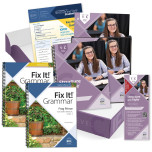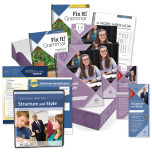We use cookies to make your experience better. To comply with the new e-Privacy directive, we need to ask for your consent to set the cookies. Learn more.
Structure lessons for Level C, Year 1 cover: Note Making/Outlines, Public Speaking, Writing From Notes, Retelling Narrative Stories, Summarizing a Reference, Writing From Pictures, Summarizing Multiple References, from Unit 7 (Inventive Writing) – Introductions/Conclusions, Imitating Author's Styles, from Unit 8 (Essay Writing) – Basic Essay, Persuasive Essay, Personal Essay, Expanded/Super Essay, and Response to Literature. Style lessons for Level C, Year 1 cover: Dress-Ups, Sentence Openers, Decorations, Banned Words, Bibliography, Citations, and Introduction to Poetry.
SSS Level C is for students who have completed SSS Level B or who are ready for high school level work. Video instruction and assignments over the two years begin with the basics but, in general, comprise an advanced level of writing instruction; giving students excellent high school writing skills and preparing them for college level writing. Focusing on the structure and style of writing, structure is covered with nine units on note making, outlines, writing/summarizing from notes, inventive writing, essay and literary critique writing. With the goal of producing interesting and appealing writing, stylistic elements include dress-ups for sentences, sentence openers, decorations, avoiding overused words. Coverage also includes reference and research citations. Each year reviews basic units as well as expanding into new areas. Instruction is incremental and clear. Andrew Pudewa, the presenter, is humorous and entertaining while presenting with clarity and good organizational skills. Courses are easy-to-use and highly effective. Course components include a Teacher Manual, a Student Packet, Binder, and Videos; sold individually or in packages.













